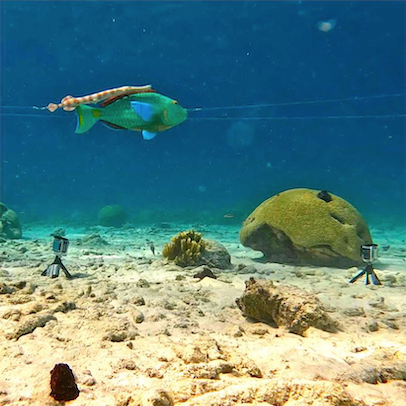The West Atlantic trumpetfish, Aulostomus maculatus, is an opportunistic predatory Syngnathiforme that is often observed swimming vertically amongst gorgonians to conceal itself from prey. But camouflage isn’t its only predatory tactic, as it’s also known to use the bodies of other non-predatory fish to hide behind, and that secondary behavior of hiding behind moving objects has got the attention of a team of researchers.
The form of concealment is known as “shadowing,” and in this case the Trumpetfish swims behind the deep-bodied Stoplight parrotfish in order to get closer to and prey upon Bicolor damselfish. The trumpetfish’s behavior is relatively well known, but its success rate has never been scientifically tested until now. And will the behavior become more adopted as sessile objects like corals become less common in the trumpetfish’s habitat?
To test it, the team 3D printed models of the trumpetfish and the stoplight parrotfish, Sparisoma viride. 36 damselfish colonies were tested across three locations, and were shown a trumpetfish, a parrotfish, and then both the trumpetfish and the parrotfish to test their anti-predatory responses.

Results
Overall, damselfish behavioral responses towards a shadowing trumpetfish more closely resembled those towards a non-predatory parrotfish than those towards a non-shadowing trumpetfish. Specifically, shadowing trumpetfish were inspected for a shorter duration inspected by a smaller proportion of each colony, and induced fewer avoidance responses compared to the non-shadowing trumpetfish; there were no significant differences in responses compared to the parrotfish treatment.
In addition, although the distance at which the first inspection event was observed did not differ significantly between treatments, treatment did have an effect on the distance at which the first avoidance response was observed damselfish showed avoidance behavior to the shadowing trumpetfish when it was closer to the colony compared to the non-shadowing trumpetfish.
“Our experimental results indicate that shadowing behavior likely reduces detection of trumpetfish by their prey, allowing trumpetfish to approach closer to prey before provoking an avoidance response. Although the exact mechanism behind the reduced responses of prey to shadowing trumpetfish remains unknown, we predict that either the partial or total occlusion of the trumpetfish by the shadowed fish reduces the ability of prey to detect the trumpetfish, although other mechanisms including distraction or misclassification may also operate. Given that visual search strategies typically involve the detection of specific animal features (for example, body outline), visual occlusion will have a significant influence on an animal’s success when searching for predators or prey.”
“Although the use of physical visual cover (such as rocky outcrops, vegetation) will often be crucial for predators’ foraging success, the use of other animals may serve as an important alternative concealment strategy when cover is unavailable. Indeed, trumpetfish are more often observed shadowing than hunting alone in less structurally complex habitats.”
“Given the global degradation of coral reefs, we may therefore expect an increase in such foraging strategies. Although we provide evidence that shadowing can serve to conceal trumpetfish from their prey, the benefits of this behavior may be multi-faceted. For example, if the shadowing species is a small mesopredator, then these animals may also profit from being less detectable by their own predators while shadowing. The same mechanism may also be used to reduce detection from aggressive or highly territorial species.”
“Overall, our study demonstrates how animals can use other animals for visual concealment, and further illustrates the diversity of strategies that have evolved in predator–prey arms races.”
More info
Read the full, open access paper here



